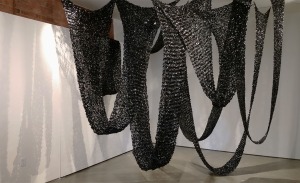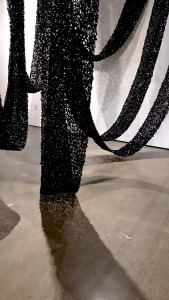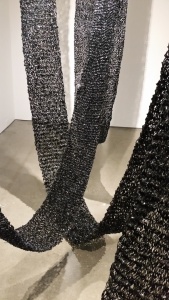Interview with Michal Gavish
Christina Velázquez is a Mexican-born multimedia artist from East Palo Alto. Her installations investigate women’s experiences and have been exhibited across the Bay Area. For her new project, Velázquez knits long shawls from VHS tape. Earlier versions of her knits have been displayed at San Francisco’s Meridian gallery in 2013 and at San Jose’s Arc Art in 2014. Velázquez recently spent a month in residency at the Palo Alto Art Center, during which she invited the local community to help her knit. The resulting long shiny black shawl was installed in November 2014 at the Palo Alto Art Center.
I spoke to Velázquez recently and a transcript of our conversation is below. It has been edited for clarity and length.
Gavish: Conceptually, what motivated you to work with VHS tape?
Velázquez: This project of knitting obsolete VHS films is connected to women’s issues and to recycling. The work is about women as part of the community. Through the knitting I wanted to address how, as women we work together to make handwork. While women crochet and knit, important issues transpire from their dialogs. I wanted this project to engage the knitters in conversation about recycling and to become part of a continuation of that dialog. The concept for my work came about when I encountered at the Museum of Quilts in San Jose a knitted piece made of cassette music tapes. That gave me the idea of reprocessing material by knitting.
I was thinking about the black shawls that old women wear in the villages of Mexico. These women were older and the knitted shawls were characteristic of their generation. They covered their heads and reminded me of the Virgin Mary. I wanted to make such shawls from VHS films, which used to be so shiny. I wanted to marry in my work the two ideas of the old women and the old VHS films, both at the end of their lives, on their way to the landfill, close to their death.
Gavish: How did you learn about knitting film? How is it different from other materials?
Velázquez: I had a lot of VHS film in my studio, and I decided to learn how to knit it. I started to learn at the Palo Alto Library where the community members were invited to be part of a knitting circle. For six months we knitted scarves and, as soon as I completed my second scarf, I realized that I was ready to make my oversized scarf from VHS films. These films, which were not intended originally for knitting, became like a lot of my art materials that I push and pull, wanting to get them to behave completely differently from what they were intended for. This process of forcing materials is sometime painful and hurts me physically but I really push these objects to obtain their new application.
Gavish: What was the process in which you have worked with the Palo Alto art center collecting the material, organizing the community knitting and finalizing the installation?
Velázquez: The residency started when the Palo Alto Art Center sent out a call to the community, asking for donations of used and unwanted VHS tapes. Within hours they received hundreds of old VHS films from residents.
The next step was for me to sit and knit a long shawl from these films in the glass gallery and to invite people to join me in the work. My expectations were to create a large shawl that would take up the entire gallery space and to have a lot of people helping with growing the piece quickly. The process turned out to be slower and the piece did not really materialize to the full size that I had envisioned. Still, we had some amazing people with great stories that they shared about their background. Some of them were even professional knitters.
Lisa Ellsworth, the Palo Alt Art Center curator, did the installation itself. She hung the large piece using plastic filaments and her vision and perspective were very important for me. The only visual points that I had were to have a very large organic shaped oversized drape and to be able to project its shadows on the walls. Those were my only take.
Gavish: What are your plans for the future? How do you intend to continue your knitting project?
Velázquez: My Palo Alto Art Center residency was an important step for my project because in that space my work finally became a complete installation. Beforehand, I made just one or two smaller pieces. Now it was a large installation that was taking up the exhibition space. For the future, I have in mind a couple of places to apply to continue my project. I plan to work in different galleries and knit more of my films with audience participation. I do hope for it to go on as a community project, where I engage the public in conversations about recycling and about issues connected to women.
On View at the Palo Alto Art Center
1313 Newel Street, Palo Alto
©2014
michalgavish.com
Follow Michal Gavish on Twitter
@Michal_Gavish
Filed under: Christina Velázquez, Michal Gavish, Palo Alto Art Center |






Leave a comment